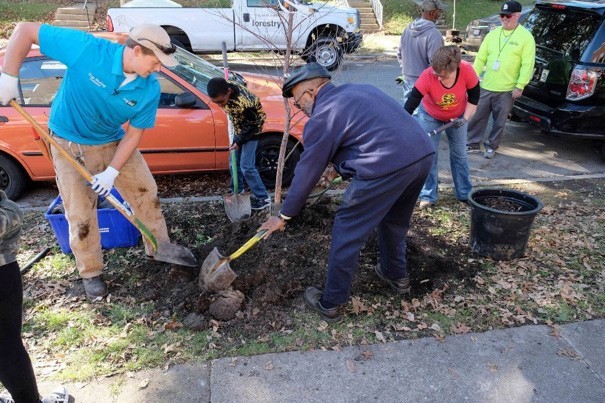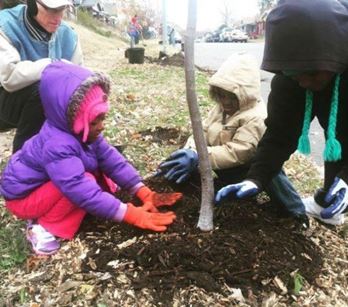AgEBB-MU CAFNR Extension
Green Horizons
Volume 21, Number 3
Fall 2017
Agroforestry
Forest ReLeaf helps replace trees lost to EAB
By Tom Ebeling| Forest ReLeaf of Missouri
In September of 2016, the City of St. Louis began removing ash trees in response to the emerald ash borer (EAB) infestation. Thanks to grant funding from the Mysun Charitable Foundation, National Fish and Wildlife Foundation, and Wells Fargo, Forest ReLeaf of Missouri began planting new trees where ash trees once stood.
Forest ReLeaf hosted four planting days in November and December in the First Ward of St. Louis, planting approximately 50 trees at each event. Two seasonal volunteers from our organization were instrumental in the success of these events. They recruited neighborhood residents through door-to-door canvassing, posting fliers in local restaurants and convenience stores, and contacting congregations and schools in the area. They even got local businesses to help sponsor the events by providing coffee and doughnuts for the volunteers. All these efforts have resulted in establishing relationships among Forest ReLeaf, local businesses, and even the residents themselves!
The days of the plantings, volunteers ranging in age from 4 to 75 showed up and collectively planted 200 new trees in their yards. Getting the residents involved was crucial. By enabling the residents of these neighborhoods to plant the trees themselves, they now have a sense of ownership. With ownership comes stewardship thereby increasing the trees' chances of survival and growth.
 |
Across four neighborhood events in Ward One, volunteers ranging in age from 4 to 75 planted 200 trees, representing a variety of native species, to replace the ash trees lost to EAB. |
In addition to the 200 trees planted by residents, City of St. Louis forestry workers have planted another 600+ trees in the First Ward.
To ensure success, native species known to be long- lasting and relatively low-maintenance street trees were selected. The newly planted trees represent 35 different species, all native to the state of Missouri. In neighborhoods that were once entirely shaded by ash trees, future canopies will include black gum, sugarberry, river birch, northern catalpa, blackjack oak, Shumard oak, baldcypress and yellow-poplar, just to name a few of the 35 species.
To date, Forest ReLeaf has provided 1,200 trees to the City of St. Louis to help offset the loss of the city's ash trees. We are taking advantage of this tragic loss of so many trees by working with the city to increase species diversity in our urban canopy and engaging heavily impacted communities to inspire stewardship of the new urban green space they helped establish.
Forest ReLeaf is continuously seeking funding so that they can reforest other heavily impacted wards throughout the city. CommuniTree Gardens Nursery, the community assisted nursery operated by Forest ReLeaf, has plans to devote its entire 7- and 15-gallon grow zones to the production of high quality, native street trees to keep up with demand as citizens seek replacements for their ash trees lost to EAB.
 |
By enabling the residents of these neighborhoods to plant the trees themselves, they now have a sense of ownership. With ownership comes stewardship. |
To learn more about Forest ReLeaf's response to EAB, visit: www.moreleaf.org/ashreleaf
